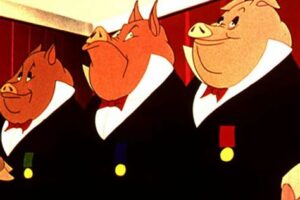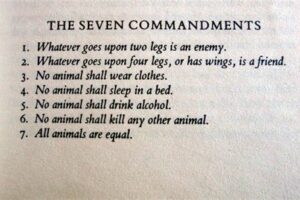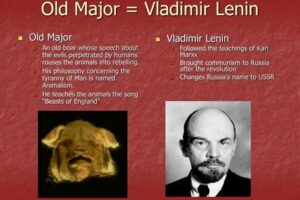Table of Contents
The allegory of Animal Farm is an influential piece of literature that uses animals to represent the events and characters of the Russian Revolution.
Animal Farm is a literary work that has captured the imagination of readers for decades, and for good reason. At first glance, it may seem like a simple story about farm animals who rise up against their human oppressors. But beneath the surface, there is a much deeper meaning at play. This is where the allegory of Animal Farm comes into play, and it’s a concept that is worth exploring in depth.
By using animals as stand-ins for human figures, George Orwell was able to craft a powerful commentary on the nature of power, corruption, and revolution. Throughout the novel, we see how the pigs, who were initially seen as benevolent leaders, begin to abuse their power and take advantage of the other animals. This mirrors the way that human leaders throughout history have used their positions to oppress those who are weaker than them.
But the allegory of Animal Farm goes even further than this. It also explores the idea of propaganda and how it can be used to manipulate people into believing things that are not true. We see this in the way that the pigs constantly twist the truth to suit their own needs, and how they use fear and intimidation to keep the other animals in line.
Ultimately, the allegory of Animal Farm is a warning about the dangers of unchecked power and the importance of remaining vigilant against those who would seek to use it for their own gain. It’s a story that is as relevant today as it was when it was first published, and it’s one that every reader should take the time to explore and understand.
The book Animal Farm by George Orwell is a classic novel that has been read and studied by many people worldwide. It was first published in 1945 and has since become a staple of literature. The novel is an allegory, which means that it is a story with a hidden meaning. This article will explore the allegory of Animal Farm and what it represents.
The Setting
The novel is set on a farm where the animals have taken control from the humans. The farm is called Animal Farm, and it is located in England. The setting is important because it represents the Soviet Union during the time of the Russian Revolution.
The Characters
The characters in the novel are all animals who represent different aspects of society. The main characters are:
- Napoleon- the pig who takes control of Animal Farm
- Snowball – the pig who is exiled from Animal Farm
- Boxer – the horse who is strong and loyal to Napoleon
- Squealer – the pig who is Napoleon’s propaganda minister
- Old Major – the pig who inspires the animals to revolt against the humans
The Plot
The plot of the novel is about a group of animals who overthrow their human farmer and take control of the farm. At first, the animals live in harmony and work together towards a common goal. However, things start to change when Napoleon takes control of the farm and becomes a dictator.
The Allegory
The allegory of Animal Farm represents the Russian Revolution and the rise of communism in the Soviet Union. The animals represent different groups of people, and their actions represent the events of the revolution.
The Pigs
The pigs in the novel represent the leaders of the Soviet Union. They are intelligent and take control of Animal Farm after the humans are overthrown. However, they become corrupt and turn into dictators, just like the leaders of the Soviet Union.
The Other Animals
The other animals in the novel represent the working class of the Soviet Union. They are oppressed by the pigs and forced to work hard for little reward. They are also manipulated by the pigs through propaganda, just like the working class in the Soviet Union.
The Themes
The themes of the novel include power, corruption, and propaganda. The pigs in the novel use their power to oppress the other animals and become corrupt. They also use propaganda to manipulate the other animals and maintain their power.
The End
The novel ends with the pigs becoming indistinguishable from the humans they overthrew. The other animals realize that they have been deceived and oppressed, but it is too late to do anything about it. The ending represents the failure of the Russian Revolution and the rise of Stalin’s dictatorship.
Conclusion
In conclusion, Animal Farm is a powerful allegory that represents the events of the Russian Revolution and the rise of communism in the Soviet Union. The novel uses animals to represent different groups of people, and their actions represent the events of the revolution. The themes of power, corruption, and propaganda are still relevant today, making Animal Farm a timeless classic.
In the beginning of Animal Farm, the animals dreamt of a society where everyone was equal and free from oppression. This fair and just society was envisioned as a metaphor for the socialist system that the animals aimed to establish. However, as the story progresses, it becomes clear that not all animals are equal in the eyes of the ruling pigs. The pigs, who were once the champions of the oppressed masses, become corrupted by their newfound power and establish themselves as a privileged elite. They use propaganda to manipulate the masses, spreading lies and distorting the truth to keep the other animals in line. In addition, they use fear to maintain their grip on power, using intimidation tactics and violence to discourage dissent and keep the other animals in check. As the pigs consolidate their power, they gradually betray the principles of the revolution that sparked the rebellion in the first place, becoming increasingly authoritarian and abandoning their commitment to equality and justice.Animal Farm can be seen as a commentary on the political climate of the early 20th century, including the rise of socialist movements and the corrupt regimes that emerged in their wake. The allegory invites readers to reflect on the nature of power and the pitfalls of political revolution. The names of the animals in Animal Farm are carefully chosen to represent various social and political groups. For example, the pigs represent the elites, while the horses and donkeys represent the working classes. Another important allegory in Animal Farm is the role of language and communication in shaping social and political reality. The pigs use their control over language to manipulate the other animals and to create a distorted version of reality.Animal Farm also explores the dangers of blind obedience and unquestioning loyalty. The animals who blindly follow the pigs and their propaganda are shown to be vulnerable to manipulation and exploitation. Despite its dark themes, Animal Farm also offers a glimmer of hope. The final chapter suggests that the animals will continue to resist their oppressors and work towards a more just and equal society. This message encourages readers to remain optimistic and continue fighting for positive social change. The allegory of Animal Farm is a powerful warning against the dangers of corruption, propaganda, and authoritarianism, urging us to remain vigilant in our efforts to create a fair and just society for all.
Animal Farm is a political allegory written by George Orwell in 1945. It tells the story of a group of farm animals who rebel against their human owner, Mr. Jones, and create a society of their own. The novel is an allegory for the Russian Revolution and the rise of Communism in the Soviet Union.
The story is told from the point of view of the animals, with each character representing a different figure from Russian history. For example:
- Napoleon, the pig, represents Joseph Stalin
- Snowball, another pig, represents Leon Trotsky
- Boxer, the horse, represents the working class
- Mr. Jones, the original owner of the farm, represents Tsar Nicholas II
The novel uses animal characters to represent historical figures in order to simplify complex political ideas and make them more accessible to a wider audience. By using animals, Orwell is able to illustrate the concepts of power, corruption, and oppression in a way that is both engaging and thought-provoking.
The allegory of Animal Farm is a commentary on the dangers of totalitarianism and the importance of individual freedom. Orwell is warning against the dangers of any political system that seeks to control the lives of its citizens without regard for their individual rights and freedoms.
Through the story of Animal Farm, Orwell makes a powerful case for the importance of democracy and the need to resist any attempts to undermine it. His message is as relevant today as it was when the book was first published over 75 years ago.
- In conclusion, Animal Farm is a political allegory that tells the story of a group of farm animals who rebel against their human owner and create a society of their own.
- The novel is an allegory for the Russian Revolution and the rise of Communism in the Soviet Union, with each character representing a different figure from Russian history.
- Orwell’s use of animal characters simplifies complex political ideas and makes them more accessible to a wider audience while illustrating the concepts of power, corruption, and oppression.
- The allegory of Animal Farm is a warning against the dangers of totalitarianism and the importance of individual freedom.
- Through the story of Animal Farm, Orwell makes a powerful case for the importance of democracy and the need to resist any attempts to undermine it.
Dear esteemed readers,
As we come to the end of this exciting journey, it is important to reflect on the allegory of Animal Farm. George Orwell’s masterpiece is a timeless political satire that has continued to captivate audiences for generations. In its simplest form, Animal Farm is an allegory that reflects the events leading up to the Russian Revolution of 1917 and its aftermath. However, its deeper meaning goes beyond the Russian Revolution to address universal themes of corruption, power, and the abuse of authority.
The story of Animal Farm follows the rise and fall of a group of farm animals who rebel against their human owner and establish their own self-governing community. The pigs take the lead in organizing the rebellion and assume leadership positions within the new society. However, over time, the pigs become corrupt and begin to abuse their power, ultimately becoming indistinguishable from the humans they had overthrown.
The allegory of Animal Farm is a powerful reminder of the dangers of unchecked power and the importance of vigilant oversight. It highlights the role of propaganda and the manipulation of language in shaping public opinion and maintaining control over a population. Through the use of animal characters and a vivid depiction of farm life, George Orwell successfully delivers his message without resorting to preachy moralizing or heavy-handed political commentary.
In conclusion, the allegory of Animal Farm is a timeless masterpiece that continues to resonate with audiences today. Its exploration of power, corruption, and the abuse of authority is as relevant now as it was when it was first published over seventy years ago. I hope this article has given you a new appreciation for the depth and complexity of this classic work of literature and encourages you to revisit it for yourself.
Thank you for taking the time to read this article.
.
Many people ask about the allegory of Animal Farm, as it is a famous novel that has been widely studied in schools and universities. Here are some common questions that people have:
-
What is the allegory of Animal Farm?
The allegory of Animal Farm is a political satire that uses farm animals to represent various figures and events in the history of the Soviet Union. The novel was written by George Orwell and published in 1945.
-
What do the animals represent in Animal Farm?
The animals in Animal Farm represent different groups of people and ideas. For example, the pigs represent the Communist Party leaders, while the horses represent the working class. The character of Napoleon represents Joseph Stalin.
-
What is the main message of Animal Farm?
The main message of Animal Farm is that power corrupts, and that those who hold power will inevitably become corrupt and oppressive. The novel also critiques the Soviet Union under Stalin, arguing that the Communist Party had betrayed its ideals and become a tool for its own self-interest.
-
What literary devices are used in Animal Farm?
Animal Farm uses a variety of literary devices, including satire, allegory, and symbolism. Satire is used to criticize political figures and institutions, while allegory and symbolism are used to represent abstract ideas through concrete images.
-
Why is Animal Farm considered a classic?
Animal Farm is considered a classic because it is a powerful critique of totalitarianism and a timeless warning against the dangers of political power. The novel’s themes are still relevant today, and its use of animal characters and simple language make it accessible to readers of all ages.
Overall, the allegory of Animal Farm is a fascinating and thought-provoking work of literature that continues to captivate readers around the world.






